| The Film - Behind the Scenes |
Click on images to enlarge |
|
|
 |
ON LOCATION: AMID FIERCE VOLCANOES, PRICELESS RUINS AND UNFORGETTABLE SUNSETS |
 |
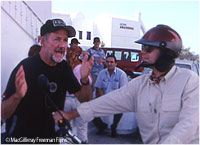 Through the eyes of the film’s detective scientists GREECE: SECRETS OF THE PAST explores two equally fascinating periods in Greek history: first, the Bronze Age when early Minoan and Mycenaean civilizations made rapid progress in trade, politics, culture and art, and began a seafaring lifestyle that demanded the tolerance of new ideas and a bold individualism that would pave the way for democracy; and then, the Classical Period from the 6th to the 4th centuries BC – the so-called “Golden Age” – when a tremendous flowering of the Greek culture began in Athens and when many of the great works of literature, sculpture, philosophy and drama that we associate with the Greeks today emerged. Through the eyes of the film’s detective scientists GREECE: SECRETS OF THE PAST explores two equally fascinating periods in Greek history: first, the Bronze Age when early Minoan and Mycenaean civilizations made rapid progress in trade, politics, culture and art, and began a seafaring lifestyle that demanded the tolerance of new ideas and a bold individualism that would pave the way for democracy; and then, the Classical Period from the 6th to the 4th centuries BC – the so-called “Golden Age” – when a tremendous flowering of the Greek culture began in Athens and when many of the great works of literature, sculpture, philosophy and drama that we associate with the Greeks today emerged.
To capture these ancient stories, the film’s crew traveled across the Greek Isles, from cosmopolitan Athens to the Bronze Age ruins of Mycenae to the famed oracle at Delphi; then on to the island of Santorini where the fallen remains of Akrotiri are yielding answers to centuries-old mysteries; to Melos, where statues such as the towering image of the oceanic god Poseidon have been retrieved (the Poseidon statue found on Melos 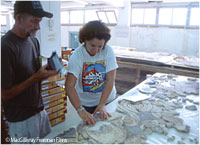 was made of marble, however the more famous bronze statue depicted in the film was recovered from the sea-floor off Cape Artemisium at the northern end of Euboea); to sacred Delos, one of Greece’s most magical locales, lined with ruins including the Lion Terrace and 2nd Century BC Amphitheatre; and then to nearby Mykonos, where Greek myth has it that Hercules slayed the Giants. was made of marble, however the more famous bronze statue depicted in the film was recovered from the sea-floor off Cape Artemisium at the northern end of Euboea); to sacred Delos, one of Greece’s most magical locales, lined with ruins including the Lion Terrace and 2nd Century BC Amphitheatre; and then to nearby Mykonos, where Greek myth has it that Hercules slayed the Giants.
“We experienced some truly remarkable locations,” says director of photography Brad Ohlund. “From the volcanic caldera in Santorini to the archeological finds of Akrotiri to the time-lapse photography we did at ancient Athenian ruins, we were amazed by how incredibly and powerfully visual this ancient story of Greece could be thousands of years later.”
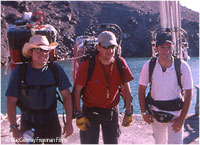 Although they had no vast mountains to climb or jungles to forge, the MacGillivray Freeman team still faced some daunting challenges in modern-day Greece. One of the biggest initial hurdles was simply getting permission to shoot in some of the most sensitive, fragile and beloved historical sites in the world. In the wake of the 2004 Olympics in Athens, with all the crowds and cameras it brought to the country, the Greeks were wary of allowing further film crews into their most prized landmarks and vital scientific sites. Admits Greg MacGillivray: “Getting the permissions we needed for production was a bit like pulling teeth – but once we were able to get through all the red tape, the famous Greek hospitality began to shine and we knew were going to have a lot of fun.” Although they had no vast mountains to climb or jungles to forge, the MacGillivray Freeman team still faced some daunting challenges in modern-day Greece. One of the biggest initial hurdles was simply getting permission to shoot in some of the most sensitive, fragile and beloved historical sites in the world. In the wake of the 2004 Olympics in Athens, with all the crowds and cameras it brought to the country, the Greeks were wary of allowing further film crews into their most prized landmarks and vital scientific sites. Admits Greg MacGillivray: “Getting the permissions we needed for production was a bit like pulling teeth – but once we were able to get through all the red tape, the famous Greek hospitality began to shine and we knew were going to have a lot of fun.”
Indeed, the filmmakers soon found themselves immersed in a contemporary Greek culture in which a deep respect for the past is matched by an equally deep love of good wine, good food and good times. The hands-down favorite shooting location for the crew quickly became Santorini, the idyllic volcanic island once part of a larger island named Thera that was shattered into chaotic pieces after an unimaginably massive 1646 BC explosion. Today, Santorini is a major tourist destination, famed for its iridescent sunsets, its miles of pristine black-sand beaches, its shimmering bleached white houses built into craggy cliffs and its sunken volcanic calderas that provide a beautiful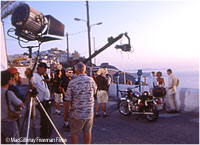 and haunting reminder of its past. “The visual drama of Santorini is simply made for the IMAX® camera,” notes Barbara MacGillivray. and haunting reminder of its past. “The visual drama of Santorini is simply made for the IMAX® camera,” notes Barbara MacGillivray.
To gain unprecedented views of the island, the filmmakers recruited the daring aerial skills of Ron Goodman. Goodman is the inventor and leading operator of a revolutionary, helicopter-mounted camera system known as SpaceCam – which uses laser focusing and a special gyro-stabilization system as a way to obtain thrilling aerial cinematography with a wider range of angles and at far greater, adrenaline-pumping speeds than ever possible before. The SpaceCam has radically changed action cinematography in feature films over the last decade and has the potential to heighten the visceral excitement of IMAX® panoramas to ever more gripping dimensions.
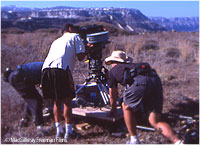 It was clear to the filmmakers of GREECE: SECRETS OF THE PAST that Goodman’s SpaceCam was a must for capturing the wonderment of Santorini from above. In their filming flights, Goodman and his Greek pilot – intriguingly named Achilles – pushed the envelope more than ever, taking a helicopter to nearly 15,000 feet of altitude, no mean feat with a 600-pound IMAX® camera (with housing) mounted on the nose. Helicopters are always dangerous but the wild heights, speeds and angles Goodman aimed for on Santorini were rife with risk. Yet for Goodman it’s all part of what he sees as his mission: to bring back images no one has ever seen before. In this case, the derring-do paid off with unforgettable, you-are-there photography of Santorini’s rugged outcroppings of rock and pumice anchored in a stunning aqua sea. It was clear to the filmmakers of GREECE: SECRETS OF THE PAST that Goodman’s SpaceCam was a must for capturing the wonderment of Santorini from above. In their filming flights, Goodman and his Greek pilot – intriguingly named Achilles – pushed the envelope more than ever, taking a helicopter to nearly 15,000 feet of altitude, no mean feat with a 600-pound IMAX® camera (with housing) mounted on the nose. Helicopters are always dangerous but the wild heights, speeds and angles Goodman aimed for on Santorini were rife with risk. Yet for Goodman it’s all part of what he sees as his mission: to bring back images no one has ever seen before. In this case, the derring-do paid off with unforgettable, you-are-there photography of Santorini’s rugged outcroppings of rock and pumice anchored in a stunning aqua sea.
“Ron had the helicopter crew turning white as ghosts with his perilous camera work, but I think he was just so inspired by this incredible landscape of volcanoes, rocky cliffs, snow-white houses and ancient ruins, he couldn’t stop himself. It’s sort of intoxicating,” says director of photography Brad Ohlund. “It’s actually hard to get a bad shot in Santorini, but I think we found ways to look at it from very fresh new angles.”
Ohlund met hardships of his own on Santorini, especially filming on volcanic terrain. “Just walking on the loose lava rock is 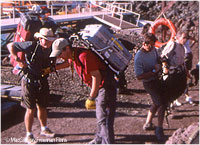 difficult enough, add a 60-lb load of IMAX® camera gear and it becomes treacherous,” he admits. “What looked on paper like it would take a few minutes to traverse often turned out to take half a day.” In one semi-comic episode, Ohlund recalls eight crew members, including the director and cinematographer, slowly, very slowly, hefting a huge generator up the side of the Nea Kameni caldera in Santorini. “For every step we took forward, we’d slide two steps back,” he laughs. “But we finally triumphed over the hill. Over all, we had a fantastic time working with our Greek crew. They brought a lot of joy and humanity to the shoot.” difficult enough, add a 60-lb load of IMAX® camera gear and it becomes treacherous,” he admits. “What looked on paper like it would take a few minutes to traverse often turned out to take half a day.” In one semi-comic episode, Ohlund recalls eight crew members, including the director and cinematographer, slowly, very slowly, hefting a huge generator up the side of the Nea Kameni caldera in Santorini. “For every step we took forward, we’d slide two steps back,” he laughs. “But we finally triumphed over the hill. Over all, we had a fantastic time working with our Greek crew. They brought a lot of joy and humanity to the shoot.”
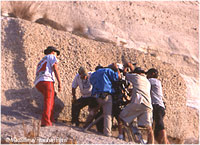 At Akrotiri, precautions for the film crew were a must. “Wherever MacGillivray Freeman Films goes we always have a policy to leave no footprints behind. But here it was even more important because with one wrong step you could destroy a priceless antiquity. This was true not only at the ruins but inside Doumas’ workshop, where they are piecing together tiny shards of frescoes like a giant puzzle. It’s just the most delicate work and we felt honored to be there,” says Ohlund. At Akrotiri, precautions for the film crew were a must. “Wherever MacGillivray Freeman Films goes we always have a policy to leave no footprints behind. But here it was even more important because with one wrong step you could destroy a priceless antiquity. This was true not only at the ruins but inside Doumas’ workshop, where they are piecing together tiny shards of frescoes like a giant puzzle. It’s just the most delicate work and we felt honored to be there,” says Ohlund.
Tragically, during the filming of GREECE: SECRETS OF THE PAST, Akrotiri experienced a deadly accident when a portion of steel roof laid over the partially reconstructed ancient town collapsed. In the wake of the incident, the entire excavation site was closed to all outsiders. The accident cast a sad pall over the production but Ohlund was heartened that the camera crews had been able to spend enough time inside the ruins and workshops to give audiences a sense of what it is like to move among the haunting ruins of a people who lived thousands of years ago. “It was really my favorite place we visited in our journey through Greece,” Ohlund says. “To be surrounded by this ancient world that has been perfectly preserved like it was packed away for future safe-keeping is just an incredibly moving experience, and one that I think lots of people who might never get to go to Greece will be able to share in this film.”
Another favorite locale was Poseidon’s Temple, perched on the cliffs above Cape Sounion, South East of Athens. Known for its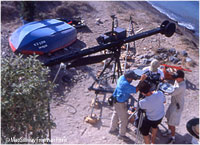 romantic sunsets, this is one of Greece’s most popular tourist destinations, which created havoc all its own. “We wanted to capture the sunset behind Poseidon’s Temple – but so did hundreds of tourists,” says Ohlund. “This called for some creative finagling to get a pristine image.” romantic sunsets, this is one of Greece’s most popular tourist destinations, which created havoc all its own. “We wanted to capture the sunset behind Poseidon’s Temple – but so did hundreds of tourists,” says Ohlund. “This called for some creative finagling to get a pristine image.”
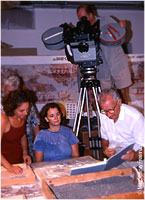 Other major tourists destinations in Athens proved equally packed, especially the Acropolis, considered by many to be the most important historical site in the world, and location of the Parthenon, one of the visual center pieces of GREECE: SECRETS OF THE PAST. Here, the crew worked feverishly to put in place unprecedented shots that would later be merged with state-of-the-art CGI. These included rare helicopter shots that were nearly lost when a Greek Sheriff in a helicopter chased the MacGillivray Freeman Films helicopter, unaware that the filmmakers had special permission to get so close to the beloved monument! To achieve the bold visuals, the film crew had to build an 82-foot dolly track on the rocky ground in front of the Parthenon – something that had never been attempted before – and had to be undertaken in the middle of the night to avoid interfering with tourist visits. Other major tourists destinations in Athens proved equally packed, especially the Acropolis, considered by many to be the most important historical site in the world, and location of the Parthenon, one of the visual center pieces of GREECE: SECRETS OF THE PAST. Here, the crew worked feverishly to put in place unprecedented shots that would later be merged with state-of-the-art CGI. These included rare helicopter shots that were nearly lost when a Greek Sheriff in a helicopter chased the MacGillivray Freeman Films helicopter, unaware that the filmmakers had special permission to get so close to the beloved monument! To achieve the bold visuals, the film crew had to build an 82-foot dolly track on the rocky ground in front of the Parthenon – something that had never been attempted before – and had to be undertaken in the middle of the night to avoid interfering with tourist visits.
Says Greg MacGillivray of the shoot at the Parthenon: “We knew it would be very difficult to carry off these complex helicopter and dolly shots at this world-famous tourist destination, but it was key that we capture this stunning symbol of democracy in a deserving way. Ultimately, we achieved perhaps one of the most time and labor intensive sequences ever created for an IMAX® theatre film: we start at dawn with a stirring helicopter shot then merge into our CGI, 3D recreation of the Parthenon, then merge that with the dolly shot of our modern-day archeologists walking through the doors and seeing before them the grandeur of the recreated Athena sculpture as it has not been seen in thousands of years.”
As the production came to a close, the filmmakers found themselves completely seduced by modern-day Greece along with its illustrious past. “Great food, great wine, great people, great learning – you can’t ask for much more than that!” sums up Lorimore.
|
 |
BRINGING ANCIENT GREECE TO LIFE WITH STATE-OF-THE ART CGI:
THE RECREATIONS OF THE PARTHENON AND THE EXPLOSION OF THERA |
 |
View
a sample clip of the CGI in the film:
|
|
|
|
To truly transport today’s audiences back in time to the life of ancient Greece the filmmakers of GREECE: SECRETS OF THE PAST ultimately had to look forward – to the very leading edge of digital wizardry. Although the camera crews’ adventuresome journeys to contemporary Greece provided compelling images of breathtaking ruins, archeological projects and oceanic vistas, the filmmakers wanted to go even further. They hoped to viscerally recreate an intimate, “virtual” experience of two key hallmarks of Greek history now lost to time: the brilliant sculptural beauty and democratic symbolism of the Parthenon before it was reduced to ruins; and the devastating volcanic explosion that blew an island to smithereens and buried a thriving culture under ash and rock on Santorini. 
Explains GREECE: SECRETS OF THE PAST writer and editor Stephen Judson: “In today’s world, no one can actually walk throughand explore the inner realms of the Parthenon as it once existed. No one can witness the eruption that blew apart Santorini. But through the magic of digital effects, we have the wonderful opportunity to give our film audience a chance not only to glimpse the past but to experience these places and events as if they were there in ancient times.”
From the beginning, Greg MacGillivray knew that recreating the Parthenon as it hasn’t been seen in the last 2,000 years was going to be a daunting undertaking, even for a filmmaker used to tackling the next-to-impossible.
One of the most famous and historically important buildings in all the world, the Parthenon remains today a powerful symbol of all that the Greeks held dear: the ideals of artistry, organic beauty and democratic participation. But sadly, over the centuries, the once lavishly decorated and brightly painted Parthenon has been ravaged by wars, invaders and time itself and reduced to partial, faded ruins. The towering 42-foot tall statue of the Goddess of Wisdom, Athena – once the focal point of the Parthenon’s interior – was long ago looted by soldiers of the Roman Empire and likely destroyed during the Crusades. Other sculptures that once adorned the Parthenon’s original structure have been damaged, destroyed or are scattered across the globe at different museums. So how could the Parthenon’s magnificence be restored on film?
MacGillivray was unsure of how to solve the problem when a stroke of luck brought him the answer. When he mentioned to his friend, feature film director Randall Kleiser, that he was working on a film about ancient Greece, Kleiser said “You have to get in touch with this computer genius at USC named Paul Debevec.”
As it turns out, Debevec – a world-renowned computer engineer and 3-D modeling pioneer – had been engaged in a groundbreaking project to use 3D scanning, digital lighting, photogrammetric modeling, image-based rendering and other cutting-edge computer-based techniques to reunite the Parthenon with its long-lost sculptures and its brightly painted frieze. Based on studies from the extensive collection of plaster casts of Parthenon sculptures at the renowned Swiss museum, the Basel Skulpterhall, Debevec’s team at the University of Southern California had been able to create an entire gallery’s worth of highly detailed “virtual sculptures.” These sculptures were then melded with three-dimensional maps of the Parthenon’s reconstructed architecture to create a kind of “virtual tour” of the Parthenon as it would have appeared to an Athenian citizen in 430 BC. MacGillivray was blown away by Debevec’s work and Debevec in turn was excited to have the chance to bring his work to a much broader audience in a major IMAX® theatre film release. After beginning work with MacGillivray, Debevec then showcased his work in a 2004 short animated film entitled “The Parthenon” which premiered at the cutting edge SIGGRAPH conference, the leading annual conference on computer graphics and interactive techniques.
Still, there remained the looming question of how to take Debevec’s work and turn it into the high-resolution, 3D imagery of a large-format film. In order to accomplish this, visual effects supervisor Matthew Muller recruited the digital artists at San Francisco-based visual effects company Matte World. Matte World’s mission: to use Debevec’s work as a jumping-off point to forge imagery of the Parthenon that would viscerally reveal the brilliant colors, life-like statuary and rippling reflecting pools that once made the Parthenon a vibrant center of Athenian life.
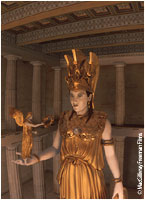 For Matte World it was a challenging but thrilling task. Matte World’s Craig Barron and Christopher Evans – who both cut their teeth creating effects for “Star Wars” director George Lucas – started with intensive research on what the Parthenon looked like in 437 BC. Barron flew to Greece to view the Parthenon’s ruins and converse with archeologists about the latest theories on the building’s design and appearance, while Evans delved into art history, learning more about the Greek’s surprisingly colorful aesthetic sensibilities. For Matte World it was a challenging but thrilling task. Matte World’s Craig Barron and Christopher Evans – who both cut their teeth creating effects for “Star Wars” director George Lucas – started with intensive research on what the Parthenon looked like in 437 BC. Barron flew to Greece to view the Parthenon’s ruins and converse with archeologists about the latest theories on the building’s design and appearance, while Evans delved into art history, learning more about the Greek’s surprisingly colorful aesthetic sensibilities.
“Paul Debevec’s footage was astonishing, pioneering, inventive, but it was also very low resolution,” explains Evans. “Part of our job was taking these 3-D images and letting a large-format film audience see them in incredible detail and authenticity. We rebuilt them at a larger size and provided new texture maps. Since we were obsessive about creating as much realism as possible out of these images, we did a huge amount of research.”
The research paid off big dividends. Evans continues: “What’s wonderful about these images you will see in GREECE: SECRETS OF THE PAST is that this is something way beyond what you could possibly see on a documentary or television show – because it’s so much more realistic and refined in presentation. These large scale images actually take you there. I think people will be blown away by it because it shows the Greeks in a very different light than we have seen them before. We think of Greek sculptures and buildings as these stark, colorless images. But that is simply because what we see has been faded. The Greek aesthetic was actually bursting with color and life – it was more like that of Mexico or Bali. And there was an emphasis on very realistic statues with flesh-tones, inset eyes and even wire eyelashes – almost like those in a wax museum. The mix of these vivid colors with the beauty of the Greek’s mathematical precision will be stunning to audiences.”
The Parthenon’s sculptural decorations are usually divided into three groups: the pediment sculptures, set on the triangular gablejust below the roof of the Parthenon, which featured larger-than-life figures from Greek myths, such as the birth of Athena from the head of Zeus; the metopes, the carved panels just under the pediment which feature detailed sculptural reliefs of mythological scenes; and the frieze which runs around the upper edge of the temple wall revealing a dynamic tapestry of horsemen, musicians, animals and various rituals of the age, which in many cases tell a story. Of tremendous artistic importance, the Parthenon was adorned with the first frieze in Greek history to depict ordinary everyday citizens, rather than simply gods and goddesses, reflecting the growing and passionate belief in democratic principles.
Each of these decorations was never intended to be the pale stone they appear to be today – rather, they were painted in crisp, bold colors that Christopher Evans likens to scenes out of a Marvel comic book. Consulting extensively with art scholars and archeologists, and using a dash of his own imagination to explore what the Greeks who painted the Parthenon might have been thinking, Evans worked tirelessly on the digital coloration to capture that playful vibrancy the Greeks had wanted to convey. “The challenge was in making the sculptures brilliantly colored without ever being garish or gaudy,” he says. “I’ve always loved classical art and there was something very exciting about choosing colors for these sculptures from thousands of years ago and getting to see them come to life.”
Then there was Athena herself, the statue long gone from the world, but essential to the recreation of the Parthenon, which was dedicated to the inspirational Goddess of Wisdom. Though the original statue is gone, art historians have a good sense of what it looked like based on other statues and replicas of Athena that still exist.
Sculpted by master Athenian sculptor and one of the Parthenon’s key designers, Phidias (490-430 BC), the colossal statue is known to have been carved in the idealistic classical Greek style known as “chryselephantine,” in which sheets of gold drapery and ivory flesh were laid over a hollow wooden armature. It is believed to have been the largest statue ever created with this technique. The monumental and life-like sculpture depicted the goddess in a lavishly decorated helmet-like crown and flowing tunic. In her left hand she supported a shield and a spear while her outstretched right hand held Nike (goddess of victory), as if Athena was extending it to the citizens of Athens. On her breastplate she bore a Medusa’s head to ward off evil. 
To prepare for creating the high-resolution image of Athena for projection on to IMAX® theatre screens up to eighty feet high,the Matte World team pored over the various replicas and recreations of Athena that exist around the world – going over each and every tiny feature. Christopher Evans looked at dozens of different depictions of the famous snake-haired monster Medusa before settling on what he felt was the right image for Athena’s breastplate. The Matte World team also consulted with scholars working at the full-scale replica of the Parthenon in Nashville, Tennessee, and utilized that replica’s 7.5-ton bronze doors for the film’s digital re-creation of modern-day explorers entering Athena’s temple. They labored over the reflective pool historians say stood before the statue of Athena, attempting to create realistic ripples in the digitally-created water when the doors to the Parthenon open. No detail was too small. “We spent months just refining the lighting, how the sun moves around the room and reflects off Athena’s gold paint,” notes Evans.
Finally, Matte World incorporated the film’s contemporary characters into the scene – using blue-screen to insert the archeologists into the digital imagery as if they, too, were able to roam the fully- reconstructed Parthenon to see what it beheld. “It’s an exciting thing to be able to explore the past with digital technology,” sums up Evans. “Basically, we did an enormous amount of researching, analyzing, thinking and imagining the reality of Greek life so that people might see the Parthenon as never before.”
Meanwhile, Santa Monica-based motion graphics company Sassoon Film Design was focusing on another dramatic digital re-creation for GREECE: SECRETS OF THE PAST – giving audiences an up-close look at a still very real and still very dangerous volcanic phenomenon that shattered the island of Santorini and beyond in 1646 BC: pyroclastic flows. One of the most destructive of all volcanic processes, pyroclastic flows are terrifying avalanches of gas, rock and lava that can attain temperatures above 1,000 degrees and move at over 100 miles per hour, following the topography of the land. The flows essentially knock down, carry away, shatter or burn down any object they encounter, leaving nothing but destruction in their wake.
This is exactly what happened in the Greek Isles at the height of the Bronze Age, toppling a sophisticated Minoan civilization that scholars are still trying to better understand today. While archeologists investigate the mystery of what happened to the people of Santorini – who appear to have disappeared before the volcano destroyed their island – geologists continue to try to understand the volcanic phenomena and the lessons it might hold for avoiding large losses of life in future catastrophes.
The eruption at Santorini is considered to be one of the largest in history, and certainly the most massive volcanic explosion in the last 10,000 years. The event likely began with destructive earthquakes that gave the populace warning of what was to come, causing them to evacuate with many of their most valuable possessions while leaving behind the incidentals of life and objects too large to transport. Then came a pair of smaller eruptions, which showered the island with a thin layer of pumice and ash. Finally came the massive explosion itself, which no living creature could have survived.
 |
Click on image and scroll to view full detail |
The boom was heard as far away as Sweden. Tsunamis rocked the ocean afterwards and the surrounding areas were dark for months. With some 7 cubic miles of magma expelled, the volcano collapsed, leaving behind a massive crater, an unimaginably huge plume of ash and the resultant pyroclastic flows. A rush of hot, sticky mud and cataclysmic “rock bombs” were ejected out of the crater. Within about a week’s time, some 70 meters of volcanic deposits had buried Akrotiri, perfectly preserving the town’s frescoes, pots, pans and structures exactly as they were left behind.
These cataclysmic events seem to defy imagination. So Judson asked Sassoon Film Design’s team to look for a way to give GREECE: SECRETS OF THE PAST audiences the feeling of being caught in the middle of a pyroclastic flow such as the one that followed the killer eruption at Santorini – but without any of the devastating danger. It was a dismaying proposition.
“We essentially had to figure out a way to give audiences a sense of what Minoans experienced – but without having any images of an actual event to use!” comments Tim Sassoon. “We quickly realized that a full CGI solution could not accurately capture the extremely complex phenomenon of pyroclastic flows. It just wasn’t real enough. So we looked for ways to re-create what happened 2,500 years ago with more modern footage that we then digitally enhanced for the 3-D environment of the film.”
Simply finding any footage of pyroclastic flows, due to their deadly nature, was easier said than done. “There are still very few images of pyroclastic flows available and almost all of it is on very low-resolution video because they are simply too dangerous to film with a motion picture camera,” explains Sassoon. “We had to do some hunting to find good footage and then, one of our biggest main challenges was simply bringing the footage up to the full resolution of a large-format movie. Our aim was to create a final image that would appear at once cinematically plausible and also scientifically accurate.”
To do all this, the artists at Sassoon Film Design had to take a mini-course in volcanology. They studied new, state-of-the-art 3-D models and simulations of pyroclastic flows – which are so intricate they are usually rendered by supercomputers – so they could get a sense of the geophysics involved. Then the team scoured geological film archives across the globe for the most compelling footage they could find of recent volcanic explosions. They came up with some eye-popping video, including recent shots of the spectacular eruption of Montserrat in the Caribbean in 2003, which also resulted in deadly pyroclastic flows. Finally, Sassoon Film Design melded these time-shifted images of the flows seamlessly into the film’s high-resolution, large format photography, and their mission was accomplished.
“Using a mixed CGI-and-stock-footage solution, we were able to create a brand new scene that illustrates the destruction of Santorini and fits right into the style of the film,” explains Jonathan Banta, the Lead Animator at Sassoon. “It’s a way of traveling in time to an incredible event no one living today could possible have ever seen, yet is a key part of the history of ancient Greece.” |
|

